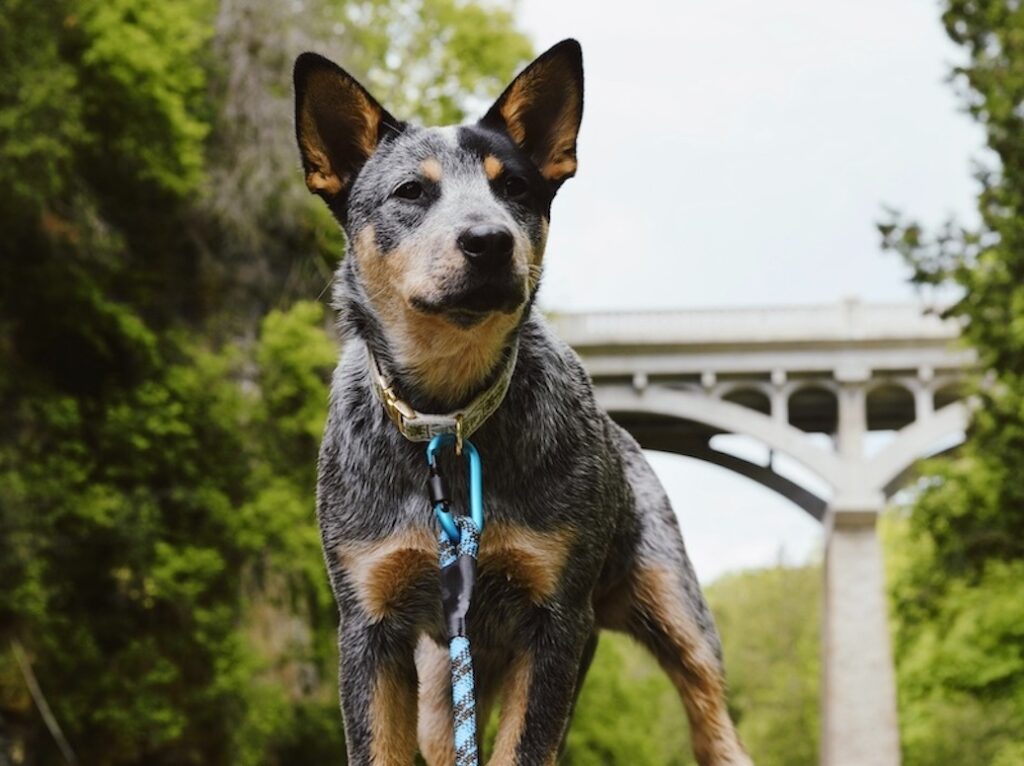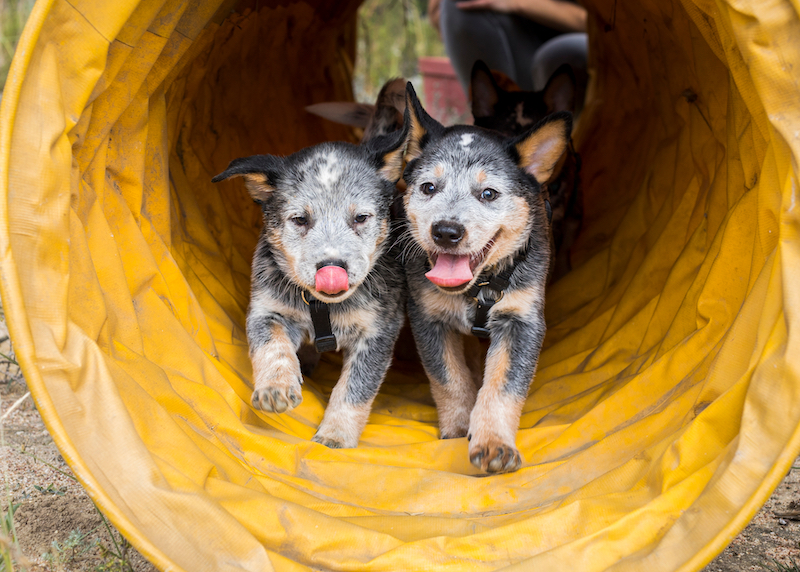- Fast facts about Blue Heelers
- Getting pet insurance for your Blue Heeler
- History of the Blue Heeler
- Characteristics of the Blue Heeler
- Health considerations of Blue Heelers
- How does a Blue Heeler’s personality compare to how they’re portrayed on the hit Australian children’s show, Bluey?
- Adopting a Blue Heeler
Hailing from Australia, the Blue Heeler has left a significant paw print in the world of dog breeds—and more recently, in children’s TV programming.
If you’re a fan of Bluey, you (and your kids) might wonder how the actual dog breed stacks up to its animated counterpart. So let’s take a look at what Blue Heelers are like IRL.
This dog breed is referred to by several names, including:
- Blue Heeler
- Australian Cattle Dog—the official name recognized by the American Kennel Club
- ACD, for short
- Queensland Heelers
- Halls Heelers
Blue Heelers were originally bred for herding cattle in the Australian Outback—hence their namesake—but their loyal, intelligent, and protective nature can also make for a great family dog.
A purebred Blue Heeler puppy can cost between around $600 to $1,000, with some premium lineages costing sometimes over $2,000.
If you’re considering a Blue Heeler as your next canine companion, read on.
Fast facts about Blue Heelers
| Personality | Energetic, Loyal, Intelligent |
| Size | Medium |
| Weight | 30-50 pounds |
| Coat | Dense, double coat (smooth undercoat and harsh outer coat) |
| Coat color | Blue or red speckle/mottled, often with tan markings on the legs, chest, and head |
| Lifespan | 12-15 years |
| Lifestyle fit | Active household with plenty of space for exercise |
| Average lifetime cost | $10,000-20,000 |
Getting pet insurance for your Blue Heeler
Pet insurance helps cover the costs of your Blue Heeler’s medical expenses. You pay a monthly premium and in exchange, you can provide care for your fur fam without stressing as much about the costs.
With Lemonade pet insurance, for example, Blue Heeler parents can customize their policy to get the coverage their furry friend needs.
For starters, a basic Lemonade pet health insurance policy includes accident and illness coverage. This will help cover the costs of tests, treatments, and medication if your dog—or cat—has an unexpected accident or illness.
A basic policy is great for the unexpected things in your fur fam’s future, but Lemonade also offers affordable preventative care packages, designed to keep your pet healthy, and helps cover expenses you’re probably already paying for.
By adding a preventive care package to a Lemonade policy you’ll be covered for all types of routine care—like annual wellness exams, checkups, blood tests, several vaccinations, dental cleanings, and other routine health care for your pet.
Get a quote for the best pet insurance plan for your furry friend.
History of the Blue Heeler
The creation of the Blue Heeler was no accident—they’re the product of a deliberate effort to develop a dog that could handle the tough work of herding cattle across vast distances under the harsh environmental conditions of Australia.
In the 19th century, a man named Thomas Hall started breeding dogs for working cattle. Hall crossed domesticated dogs with wild Australian Dingos he had tamed. The result was a breed known as “Hall’s Heelers.”
But the Blue Heeler breed we know today came about from additional crosses to the Hall’s Heelers. In the development of the breed, several types of dogs were included in the mix, each chosen for specific traits that would make the breed more adept at their jobs.
This included breeds like:
- Dalmatian. To promote loyalty to the ranchers and their horses
- Bull Terrier. For tenacity
- Black and Tan Kelpie. For herding ability
The result of these crosses was a hardy, intelligent dog with a strong herding instinct, able to handle both the severe Australian weather and the often unruly Australian cattle. They were named for their method of moving reluctant cattle by nipping at their heels, and their distinctive blue-gray coats.
Characteristics of the Blue Heeler

According to the American Kennel Club (AKC) and the Australian Cattle Dog Club of America’s breed standard, the Blue Heeler is a medium-sized, active, and sturdy dog.
Here’s a breakdown of the main characteristics of Blue Heelers, detailing their training, friendliness, adaptability, physical needs, and health needs using a rating scale of low, moderate, and high.
Keep in mind that these are general characteristics for the average Blue Heeler, and don’t represent the entire breed.
Training
| Characteristic | Rating |
|---|---|
| Ease of training | Moderate |
| Intelligence | High |
| Prey drive | High |
| Tendency to bark | Moderate |
| Wanderlust potential | High |
Friendliness
| Characteristic | Rating |
|---|---|
| Affection level | High |
| Kid-friendly | Moderate |
| Dog-friendly | Moderate |
| Stranger-friendly | Low |
Adaptability
| Characteristic | Rating |
|---|---|
| Apartment-friendly | Low |
| Good for novice owners | Low |
| Sensitivity level | High |
| Tolerates hot weather | High |
| Tolerates cold weather | Moderate |
Physical considerations
| Characteristic | Rating |
|---|---|
| Energy level | Very High |
| Exercise needs | Very High |
| Playfulness | High |
| Grooming needs | Low |
Health considerations of Blue Heelers
Blue Heelers are generally robust and healthy dogs, but they can still be prone to specific health issues.
Deafness
This can affect one ear (unilateral) or both ears (bilateral), and is linked to the pigmentation genes responsible for a Blue Heelers’ distinctive coat colors.
Progressive retinal atrophy
A hereditary disease that eventually leads to blindness. We suggest you ask your breeder about the parent’s eye history to avoid this condition.
Hip dysplasia
A genetic condition where the hip joint doesn’t develop properly, leading to arthritis and pain. Regular check-ups with your vet and maintaining a healthy weight can help reduce the risk of hip dysplasia.
How does a Blue Heeler’s personality compare to how they’re portrayed on the hit Australian children’s show, Bluey?
‘Bandit’, the animated Blue Heeler dad from the show Bluey, fairly accurately mirrors the behavior of actual Blue Heelers. His high-energy antics and problem-solving prowess in the imaginative games he plays with his pups, Bluey and Bingo, are true to the nature of this smart breed.
“I was being out-parented by a cartoon dog. Bandit was everything I couldn’t live up to. Available. Mental space for play. Aware of his own shortcomings. Non-stressed. Even when he got things wrong, he found ways of making it better. Bandit’s an all-round good guy. So why did he rankle?”
–Doug Hendrie, on feeling inadequate compared to a cartoon Blue Heeler
Bandit’s loyalty to his family and interactive nature parallels the traits of real Blue Heelers, often considered one of the most intelligent and hardworking of herding dogs. Despite being an animated character, Bandit also portrays the Blue Heeler’s stubborn streak, setting boundaries for his pups while providing balanced, fair discipline.
Shows like Bluey have a significant impact on perceptions of dog breeds (just like what Lassie did for the rough-coated Collie). The character Bandit successfully projects the energy, intelligence, and loyalty of the Blue Heeler breed, shaping public understanding of this unique herding dog and beloved family member.
Keep in mind that Blue Heelers have high energy levels. They require consistent, firm training and socialization from an early age, and plenty of physical exercise and mental stimulation to help keep them happy and healthy (and to prevent them from nipping at your heels in an attempt to “herd” you).
Warning: Don’t expect your Blue Heeler puppy to instantly go into “dance mode” simply by touching its tail.
Adopting a Blue Heeler

Adopting a Blue Heeler can be a rewarding and potentially more affordable alternative to buying a puppy from a breeder. Adoption fees typically range from $200 to $500, and this usually covers initial vet care, vaccinations, microchipping, and spaying or neutering.
There are numerous rescue organizations and shelters dedicated to finding loving homes for Blue Heelers and similar breeds, both as puppies and adults, including:
- Australian Cattle Dog Rescue Association (ACDRA)
- Texas Cattle Dog Rescue
- Arizona Cattle Dog Rescue
- New Hope Cattle Dogs Rescue
By choosing to adopt, you provide a deserving dog with a second chance at a happy life while also supporting rescue efforts.
And don’t forget!
Your Heeler is a bundle of cuteness, and you want to keep that pup happy and healthy—while also protecting your wallet. Enter Lemonade’s Pet, which offers an affordable way to make sure your furry friend can live their life to the fullest.
Getting your quote takes just a few minutes, with a dog insurance plan that Blue Heelers and their pet parents both love!
A few quick words, because we <3 our lawyers: This post is general in nature, and any statement in it doesn’t alter the terms, conditions, exclusions, or limitations of policies issued by Lemonade, which differ according to your state of residence. You’re encouraged to discuss your specific circumstances with your own professional advisors. The purpose of this post is merely to provide you with info and insights you can use to make such discussions more productive! Naturally, all comments by, or references to, third parties represent their own views, and Lemonade assumes no responsibility for them. Coverage may not be available in all states.




